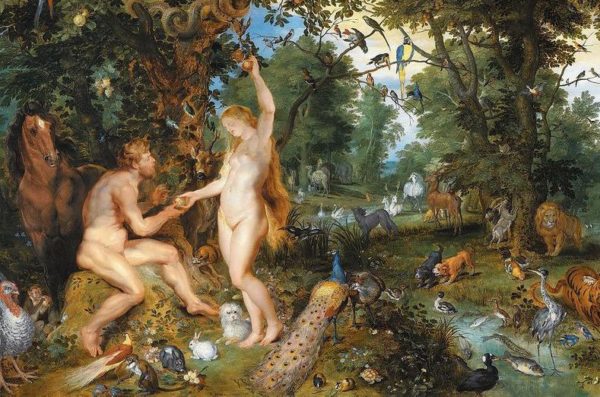The Scientific Possibility of Adam and Eve
by Dr. Dennis Bonnette
Filed under Evolution

Until the advent of Darwinian evolution, most Christians believed that the entire human race actually descended from our literally-real first parents, Adam and Eve. Many still do. In 1950, Pope Pius XII issued an encyclical, Humani Generis, in which he wrote that “revealed truth and … the magisterium of the Church teach” that Original Sin is "a sin truly committed by one Adam [ab uno Adamo], and which is transmitted to all by generation, and exists in each one as his own."1 The current Catechism of the Catholic Church: Second Edition tells us that “Adam and Eve committed a personal sin” … “which will be transmitted by propagation to all mankind….”2
Still, this account of our literal first parents and Original Sin, which is the essential rationale for the need of Christ as a Redeemer, has been challenged by modern scientific claims on two fronts: (1) the Christian belief that true man suddenly appeared in the form of Adam has been replaced with the standard theory of human evolution in which progressive changes in early primates evolved the consciousness and intelligence of modern man, with no clear line of demarcation marking his initial appearance, and (2) the claim that our human species arose from a single pair of first parents has been replaced with evolution taking place in large populations whose number never saw a bottleneck (reduced population) of just two individuals.
The former claim arises largely from the evidence of paleoanthropology, revealed in the gradual, progressive development of tools over time, and the latter arose particularly from the work of geneticist Francisco Ayala, whose often-cited mid-1990s studies maintained that the human population never was fewer than several thousand individuals.
Instant Appearance of the First True Human Beings
Paleontology discovers progressive improvement in tools made by evolving primates, which seems to correlate with development of hominin brains and anatomy. (Hominin is a term that includes recent humans together with extinct ancestral and related forms.) This sequence finally blends into the sophisticated tool-making and other abilities of modern man. Yet, there appear to be no sudden signs of a “spiritual-souled” Adam. Neo-Darwinists infer that all this improvement can be explained in naturalistic terms. Yet, what these facile materialist scenarios overlook is the fact that the rational case for man’s essential superiority over brute animals remains robust. Christian philosophy argues that true man is marked by intellectual activities of understanding, judging, reasoning and free will that manifest the spiritual soul’s presence.3
Complex sentient behaviors of irrational animals enabled early primates to produce primitive stone tools, even including early Acheulean stone hand-axes exhibiting some symmetry—wrought by Homo erectus hominins dating back 1.4 million years. Still, it wasn’t until the early Middle Pleistocene period, some three-quarters of a million years ago, that later hand-axes appeared having a congruent, three-dimensionally symmetrical shape that apodictically demonstrates true human intellection.4 This, as well as evidence of early controlled use of fire, appears about that time— evincing the first unequivocal presence of the human spiritual soul. These sophisticated artifacts may be viewed as scientific evidence, which also has an important philosophical implication, namely, that such artifacts necessarily imply the activity of an intellectual agent – a qualitatively superior, true human being with a spiritual soul.5 True man may have been present earlier, but remains thus far undetected.
Since mere matter can never evolve into spirit, true man must have appeared instantly at some point —regardless of the misreading of fossil tool evidence by Neo-Darwinians. Scientific failure to detect that fact and that moment in no way undermines the philosophical necessity of its reality. The scientific possibility of a literal Adam and Eve remains intact despite the gradual improvement of toolmaking. Moreover, the philosophical proof that there must be a first true human being lends support to the credibility of Adam and Eve, since having a spiritual-souled first true man is part of that biblical account.
The Challenge Posed by Modern Genetics
Until very recently, it has been accepted scientific dogma that human beings could not have arisen from a single mating pair of first true humans. This claim has been based on the distribution of single nucleotide polymorphisms in the human population, and coalescence and lineage disequilibrium studies. Researchers have estimated the hominin population at the time of our origin had to be in the thousands. Indeed, some researchers claim that there has never been a hominin population smaller than one thousand in the last two million years.6
Yet these estimates are subject to confounding error because of the assumptions involved, for example, “...a constant background mutation rate over time, lack of selection for genetic change on the DNA sequences being studied, random breeding among individuals, no migrations in or out of the breeding population, and the assumption of a constant population size,”7—such that DNA sequence differences (polymorphisms) alone are insufficient to determine effective population size.8
Perhaps the best example of such a failure is the study by geneticist Francisco Ayala published in Science (1995),9 in which he claimed that a mating pair of just two first true humans was scientifically impossible. Ayala based his claim on the large number of versions (alleles) of the gene HLA-DRB1 that are found in the present human population. Ayala claimed that there were thirty-two ancient lineages of HLA-DRB1 prior to the Homo (human)/Pan (chimpanzee) split, which he said occurred six million years ago. The problem is that each individual carries only two versions of a gene – so that there would be no way that just two individuals could have possibly passed on all those alleles at any time since the lineages split. A bottleneck (reduced population) of just two true human beings, Adam and Eve, appeared to be scientifically impossible.
But it turned out that Ayala’s claim of thirty-two ancient HLA-DRB1 lineages contained methodological errors. The DNA he chose was subject to strong selection, hypermutation, and gene conversion, which skewed his results. Recognizing the problem, Tomas Bergström et al. published a study (1998) showing just seven such alleles at the time of the Homo/Pan split, with most of the present genetic diversity appearing in the last quarter million years.10 Still later, another study (2007) by von Salomé et al., inferred that only four such lineages existed more than five million years ago, with a few more appearing shortly thereafter.11
While this article is too short to analyze all the genetics pertinent to these studies, often overlooked is the inherent epistemic weakness of these retrospective calculations. It is all too easy to make false assumptions that invalidate results. The assumptions of random breeding among individuals, constant mutation rates, or constant population size may be incorrect. Even the methods used for analysis can make a difference. One need merely think of the errors already noted in present day computer models about trends of climate change.
Indeed, claims that “Adam and Eve are scientifically impossible,” are not scientific, as science is always subject to revision, as we shall see.
The Proposed “Interbreeding Solution”
Given the seemingly problematic genetics of a literal Adam and Eve, philosopher Kenneth W. Kemp, writing in the American Catholic Philosophical Quarterly (2011), proposed an alternative solution in the form of the interbreeding hypothesis, that is, that present genetic diversity in genes, such as HLA-DRB1, might be explained through interbreeding between Adam and Eve’s true human descendants and their subhuman “relatives” in the same biological population.
Kemp’s hypothesis meets the theological requirements that Adam and Eve must be the first true human beings and that all true humans today must be their biological descendants. In any such scenario, the possession of intellect by true men would enable them to outcompete their subhuman “cousins,” thus explaining why such nearly identical subhumans are no longer extant.
Given that studies by Bergström et al. and von Salomé et al. showed that many fewer excess alleles need to be explained than Ayala initially claimed—but that the estimate hovers on the border of what can pass through just two ancestors, it is possible that such an interbreeding solution might still be needed in order to explain present genetic diversity.
But, the question remains as to whether such a potentially ethically-problematic solution, entailing sexual intercourse between true men and subhuman animals, is really necessary.
More Recent Genetic Studies
In 2017, a series of unexpected events occurred that amply illustrate the need for caution in making claims about human beings’ origin. Biologist Dennis Venema published the claim that it was as certain as that the earth revolves around the sun that we came from a population of thousands. This precipitated a prolonged discussion by scientists on the website, Biologos, which revealed that, despite all the claims, no one had directly tested whether or not we could have come from a first human pair. Recounting the story at Evolution News, molecular biologist Ann Gauger described how two scientists decided to finally directly test the possibility. They ran different computer models and, amazingly, they found that:
“A bottleneck of two that is older than 500,000 years ago cannot be ruled out. That does not mean such a bottleneck ever existed, but rather that the possibility cannot be excluded. Future models may change that number of 500,000 years, up or down...
This is based on an analysis of the genetic data run by Drs. Schaffner and Swamidass, themselves evolutionary biologists and not ID supporters.”
In the context of a lengthy and highly technical analysis on his blog, Dr. S. Joshua Swamidass, summarized the results as follows:
“A very recent bottleneck (say 50 kya) seems impossible, but a more ancient bottleneck of our ancestors (if very brief) at 500 kya might be consistent with the evidence. Sometime before 500 kya, this couple would not be Homo sapiens, but they might (exact dates debatable) be the common ancestor of Homo sapiens, Denisovans, and Neanderthals.”
Swamidass realized that there was yet another way to disprove a first pair. If it could be shown that human beings share too many alleles (more than four) of any gene with chimps or gorillas, that would argue for our common descent from a population of more than two. (Adam and Eve could pass along only four.) This passing along of alleles between species by common descent is known as trans-species polymorphism (TSP). The gene family most likely to demonstrate TSP is the HLA family, including HLA-DRB1, the gene Francisco Ayala studied in 1995 in an attempt to demonstrate Adam and Eve were not possible.
In light of the model results described above, Dr. Swamidass re-examined Ayala’s work. Swamidass found a paper, published in BMC Evolutionary Biology (2016), that analyzed the genetic networks of HLA genes, along with about 12,000 other genes. This study found that the apparent TSP of HLA-DRB1, along with other HLA genes (HLA-DPB1, HLA-C, HLA-A, and HLA-B), is probably due to convergent evolution. Human alleles are mutating over time toward the same sequence, likely due to selection that favors that sequence.
Referring to the results of that paper, Swamidass notes, “… HLA-DRB1 is the most variable HLA gene. It is notable for having over 500 squares in the DNA of about merely 1,000 individuals, compared with an expected number of less than 10. That means if we had tried to put the DNA into a tree, we would see at least 500 mutations discordant with a phylogenetic tree. This is just a stunning result, because it means that HLA-DRB1 alleles are just not well described as a tree.”
What Swamidass means is that HLA-DRB1 shows signs of convergent evolution. The 500 squares he refers to are places where the HLA-DRB1 DNA sequence is more similar than it should be, showing signs of converging on a particular sequence. Thus any similarity between chimpanzee and human HLA-DRB1 sequences is probably due to convergent evolution also, not TSP. This considerably weakens TSP as a challenge to a first pair.
Any conclusions based on the assumption of TSP are called into question. At this point, it seems even TSP cannot be used to rule out a first hominin mating pair.
This is on-going, exciting research, not yet published in a peer reviewed journal. It shows that the claim that we had to come from a population of thousands was based on presumption and not proof. The claim that a first pair is impossible, when tested directly, was wrong. Finally, a first human mating pair is possible, but not proven.
I am indebted to Dr. Ann Gauger, who pointed out all this recent research and its implications to me, and who has assisted me in my preparation of the scientific sections.
Conclusion
It was never the intent of this paper to offer scientific proof of Adam and Eve’s literal reality. The sole purpose has been to show that they are not scientifically impossible.
Based on the best available evidence and analysis, this goal has been achieved.
The most recent research indicates that the best likelihood for there being two first parents for the human race is prior to half a million years ago. This finding comports significantly with my own speculation stated at the beginning of this article, namely, that, based on intellect-evincing artifacts, the probable time for the first true human beings—Adam and Eve—would be some three-quarters of a million years ago.
This philosophical inference that the makers of such artifacts must be true human beings means that they would be proper candidates for being identical with the possible “first hominin mating pair” discussed in the previous section.
And yes, as Swamidass points out, given their ancient time frame, this would make them “the common ancestor of Homo sapiens, Denisovans, and Neanderthals.”
Few understand that adequate speculative treatment of a literal Adam and Eve requires proper correlation of three disciplinary perspectives: theological, philosophical, and natural scientific. Theologically, Adam and Eve must be the first true human beings and all true men must be their descendants. Philosophically, the first true man must be the first hominin possessing intellect and a spiritual soul – as evinced by artifacts, such as those artistic stone hand axes of three-quarters of a million years ago. This is the reason why “candidates” proposed more recently in time cannot possibly be the true first parents, since there is evidence that true humans would chronologically precede them. Finally, in terms of natural science, it must be shown that – unless there is need for recourse to the interbreeding hypothesis – a bottleneck of just two true first human beings is possible. A credible case for that very possibility in the speculative time frame that I propose has just been offered, as shown above.
Therefore, a literal Adam and Eve is scientifically possible.
Of course, the positive evidence for the actual existence of a literal Adam and Eve lies, not in natural science or philosophy, but in the two thousand years of Christian miracles, singularly embodied in the death and resurrection of Jesus Christ, the Redeemer promised by God to our first parents, Adam and Eve, after they had personally committed Original Sin. To Christians, these miracles, especially when combined with the newfound evidence for the scientific possibility of a literal Adam and Eve, will serve to demonstrate the rational credibility of this foundational doctrine of the Faith.
Related Posts
Notes:
- Humani Generis, n. 37 ↩
- CCC, 404. ↩
- Dennis Bonnette, Origin of the Human Species (Sapientia Press, third edition, 2014), 69-71,103-110. ↩
- Ibid., Preface to Third Edition, xiv. ↩
- Ibid., 163-164. ↩
- John Hawks et al., “Population Bottlenecks and Pleistocene Human Evolution,” Molecular Biology and Evolution 17, no. 1 (2000): 2-22. ↩
- Ann Gauger, “The Science of Adam and Eve,” in Science and Human Origins, Ann Gauger, Douglas Axe, and Casey Luskin (Seattle, WA: Discovery Institute Press, 2012), 105-122. ↩
- P. Sjödin, I. Kaj, S. Krone, ‡M. Lascoux and M. Nordborg, “On the Meaning and Existence of an Effective Population Size,” Genetics 169 (February 2005): 1061–1070 ; J. Hawks, “From Genes to Numbers: Effective Population Sizes in Human Evolution,” in Recent Advances in Paleodemography, ed. Jean-pierre Bocquet-Appel (Springer Netherlands, 2008), 9-30. See also, Dennis Venema and Scot McKnight, Adam and the Genome: Reading Scripture after Genetic Science (Brazos Press, 2017). ↩
- Francisco J. Ayala, "The Myth of Eve: Molecular Biology and Human Origins," Science 270 (1995):1930-1936. ↩
- Tomas Bergström et al., “Recent Origin of HLA-DRB1 Alleles and Implications for Human Evolution,” Nature Genetics 18 (1998): 237-242. ↩
- Jenny von Salomé et al., “Full-length sequence analysis of the HLA-DRB1 locus suggests a recent origin of alleles,” Immunogenetics (2007) 59: 261–271. ↩
Note: Our goal is to cultivate serious and respectful dialogue. While it's OK to disagree—even encouraged!—any snarky, offensive, or off-topic comments will be deleted. Before commenting please read the Commenting Rules and Tips. If you're having trouble commenting, read the Commenting Instructions.











